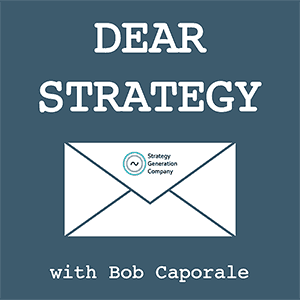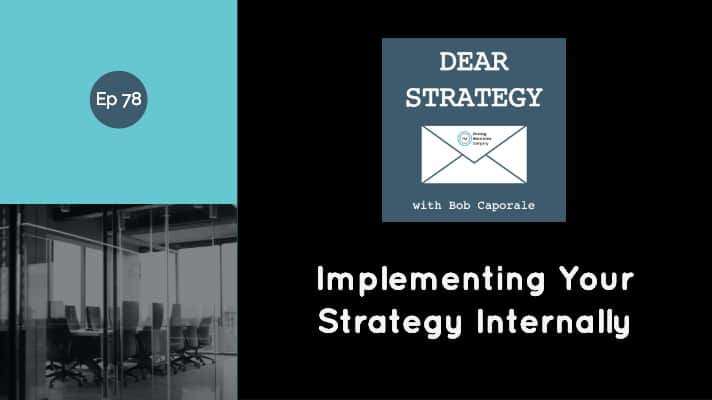Dear Strategy:
“How do you build programs, projects, and, ultimately, products out of a strategy once it’s been established and accepted? How does it look from a complete, holistic lifecycle?
This is one of those questions that might, at first, appear to be a bit on the obvious side. I mean, isn’t the whole point of a strategy to identify actions that can be turned into programs, projects, and products? But as simple as this may sound, it is actually one of the areas that tend to confuse people the most with respect to developing formal strategic plans. So, let’s dive into this one a little bit more…
When putting together a formal strategic plan, there are typically three main “sections” to be concerned with. This, according to the strategy framework used by my business (and the sponsor of this blog), Strategy Generation Company. These sections are:
- Analysis
- Planning
- Execution
In the Analysis section, you are typically analyzing the past and present states of your market, your industry, and your business. This is the part of the process where your customer, competitor, and company data gets collected, and it is also the part of the process that will serve as a foundation for the larger strategy that will follow.
The Planning section is the heart of your strategy. This is where you set your goals, sort through your strategic options, and, ultimately, choose the actions you want to take in pursuit of whatever it is you’re hoping to achieve.
Finally, we come to the Execution stage. This is the part of your strategy where you make investments, track your progress, and (hopefully) achieve your targeted results. It is in this section of your strategy where you’ll be turning your planned actions into the programs, projects, and products that are referenced in this week’s question.
The real question then becomes, how much of your execution should you outline within the context of your actual physical strategic plan? In other words, should you be expected to lay out every detail of every single action and individual investment when you are putting your plan together?
To get right to the point, my short answer is a resounding, “NO.”
The whole intention of a strategy (especially within the context of a company or a business) is to provide high-level guidance for the far more tactical actions that will ultimately follow. In this way, there is a hierarchy to be followed, almost like the folder system on your hard drive. Your folders serve to group all of your individual files so that they can be more easily accessed and understood. Without these higher-level folders, your files would appear to be more or less random. But, grouped into some sort of a logical structure, your files all of a sudden take on meaning – allowing you to not only more easily utilize them, but also to determine which ones you really want to keep and which ones you don’t.
“The whole intention of a strategy is to provide high-level guidance for the far more tactical actions that will ultimately follow.“
In this way, the strategic actions you identify within the context of your strategic plan serve as your higher-level folders. The idea here isn’t to specify every single tactical action that you will ever take but, rather, to identify several big categories (or groupings) of actions so that your individual tactics will all fit within this larger context at the time of execution.
Imagine, for example, that your engineering team comes up with some really great ideas to tweak one of your existing products. These tweaks would all represent individual tactical actions. But if your higher-level strategic action says that you want to retire this particular product from your portfolio, then all of a sudden, those individual tactics make no sense. In short, they don’t fit into any of your folders.
When developing your strategic actions, I always recommend that you include some sort of investment plan as an integral part of that task. This is not meant to serve as a detailed business case or even a request for individual project funding. Instead, it serves as an estimate of what each of your higher-level strategic actions is likely going to cost you to implement.
The reason this investment plan is so important, by the way, is that, at least in my experience, the most common cause of strategic failure is not in execution but, rather, in failing to fund execution. And that usually happens because individual projects that should be supporting your overall strategy are, instead, being treated as isolated funding exercises, untethered to any sort of a master funding plan. Allocating investment dollars at the strategic planning level should help alleviate this problem and ensure that you don’t have to fight quite as hard for funding when programs, projects, and products are actually being implemented.
The last part of this question asks about how to manage all of these dynamics with respect to a product’s complete holistic lifecycle. Well, that’s the beauty of developing your actions in these hierarchical layers that I’m talking about – you’ll always have the flexibility to shift, alter, and execute individual tactical actions without constantly having to change your higher-level strategy. Back to our hard drive analogy, you’re likely going to be changing your individual files all the time – adding them, removing them, and altering them as the current situation demands. But, through all of that, you won’t be changing your higher-level folder structure anywhere near as frequently. So, you may need to revisit your “folders” only once a quarter, or perhaps even once a year, while, at the same time, still maintaining the flexibility to make changes within those folders on nearly a daily basis.
In a nutshell, that’s the key to successful internal strategic execution – planning to act, planning to fund, funding, acting, and doing it all over again. If you follow that basic pattern, you’ll never have to worry about not executing your strategy again – mostly because you’ll be too busy actually executing it!
Listen to the podcast episode
Dear Strategy: Episode 078

###
Are you interested in strategy workshops for your product, marketing, or business managers? If so, please be sure to visit Strategy Generation Company by clicking the link below:
 Bob Caporale is the founder of Strategy Generation Company, the author of Creative Strategy Generation and the host of the Dear Strategy podcast. You can learn more about his work by visiting bobcaporale.com.
Bob Caporale is the founder of Strategy Generation Company, the author of Creative Strategy Generation and the host of the Dear Strategy podcast. You can learn more about his work by visiting bobcaporale.com.






